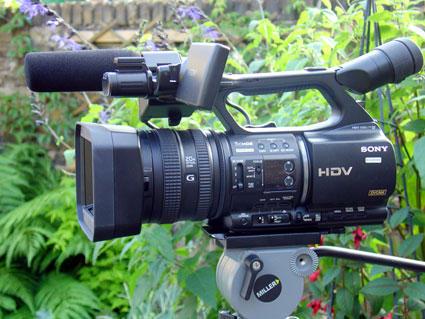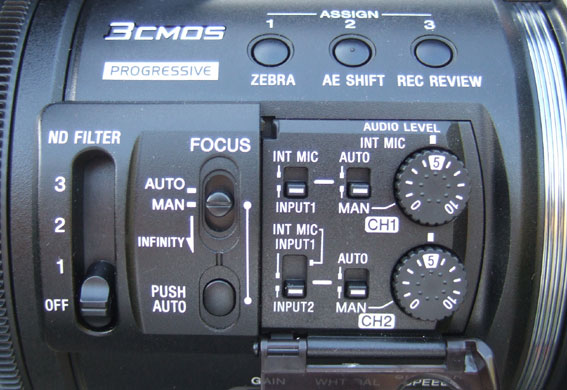
 |
| urbanfox.tv > technology articles > camera articles > Sony Z5 camera review - the Z1 replacement |
|
ON THIS PAGE:
|

Sony Z5 Camera reviewFinally there is a repacement for the Sony Z1 camera. The new HVR-Z5 should start shipping in December and was launched in Europe at the IBC (International Broadcasting Convention) in Amsterdam - September 2008. Its three 1/3-inch CMOS sensors and fixed lens output HDV, DVCAM and DV onto tape, Compact Flash or a hard disk drive. We were given a pre-production model to review a week befor the show and here are our initial thoughts on the camera. by David Fox and Christina Fox |
Direct Replacement for Z1
Its layout has been updated from that of the Z1, and its styling is similar to both the Z7 and EX1. However, anyone upgrading from a Z1 should feel comfortable with it pretty quickly. Power consumption has been reduced from about 7.4 Watts on the Z1 to 7.1W (or less), because CMOS uses less power than CCDs do, which should extend battery life a little. It uses the same batteries as the Z1 and the popular PD150/170 SD camcorders. Sony did a lot of customer research when designing this camera, bringing engineers from Japan to Europe to meet Z1 users, and it shows, most obviously in its improved ergonomics. It is also slightly lighter and more compact. The LCD flip-out display and the vewfinder both come from the Z7, and are an improvement on those on the Z1. Although the higher resolution screen is smaller on the Z5 compared to the Z1. It also boasts better low light sensitivity. Sony tried to make it as similar as possible in this regard to the PD150, which was much loved for its ability to shoot in low light, and the Z5 is about 1.5Lux (compared to the PD150's 1Lux and the Z1's 3Lux).
|
|
The LensIt has the continuous, infinity focus ring of the Z1, so if you dislike it, you'd be better off with the EX or Z7, which offer the choice of end stop or infinity. The 20x (optical zoom) lens is the widest Sony has included as standard on any of its small HD camcorders, going from 4.1 to 82mm (compared to 4.5 to 54mm on the Z1). It is a new Sony designed lens, as a few years ago it bought Conika Minolta (the stills camera manufacturer), which had its own highly skilled optical engineers, and this G lens seems to meet the same standards as the Carl Zeiss lenses on its previous low-end camcorders. It has a maximum aperture of F1.6 (the same as the Z1), but as you zoom in it ramps down to F3.4 (compared to F2.8 on the 12x Z1 lens). You can really see the difference; so don't zoom in in dark places unless you want to add in a lot of gain. The iris ring is now on the lens (unlike the Z1, but like the Z7 and EX1), which makes it more ergonomic. This is where the irs control should always be. It seems to be continuous rather than stepped, giving a lovely smooth transition from one stop to the next. The Push Auto (focus) button has once again got smaller, making it even more difficult to get at, but at least it is no longer right beside the White Balance button (as it is on the Z1), making it easier to push without affecting anything else. There is also a 1.5x Digital Extender, which hardly seemed to decrease resolution, making it potentially useful. This is a menu selection item, so you'd have to assign it to one of the seven Assign buttons (up from six on the Z1) to make it usefully accessible. There will also be a wide angle lens available (with matte box, filter holder and French flag), at "an affordable price" (about Euro 750). |
|
Light and White
There is also a really grainy Hyper Gain setting that looks pretty dreadful. But, I suppose if you really have to shoot in the dark it may come in handy. There are three ND filters (compared to 2 on the Z1), of ¼, 1/16 and 1/64 (equivalent to 2, 4 and 6 stops). If you add that to the minus gain, you should be able to achieve any depth of field you want and still get the right exposure. Shutter speeds range from 1/3 to 1/10,000 of a second and Sony has finally added ECS (Extended Clear Scan), so you can shoot a CRT computer monitor without scrolling bars appearing on it, although as most people have now switched to LCD screens, you probably won't need it. Better late than never. In the Menus, you can select to be in Iris or the new Exposure mode. It can take account of gain and shutter, changing the iris to compensate for what effect you are trying to achieve, while still retaining the same overall brightness you have already set. However, you can still independently change the iris if you want, so it is not the same as Shutter Priority. White balance: Besides the pre-set tungsten and daylight settings, there is also a user selectable preset that can be changed from 2,300K to 15,000K in 100K increments. So, if you want to make sunsets warmer than they are, this is a simple way to achieve it. It also has the usual A and B manual white balance memories.
|
|
|
|
 AudioThe HVR-Z5 has two XLR inputs and finally has a switching system that is intuitive. On the Z1, the audio switches were in the menu, but here they are physical switches again. Channel 1 can be fed by the internal mic, or whatever is plugged into XLR 1, while channel 2 can be fed by the internal mic, XLR 1 or XLR 2 (and the two XLRs can be switched from Line to Mic to Mic +48v [phantom power]). All of this is really clearly laid out on the Status Check audio screen (the first of the Status Check's six pages – displayed on the Z5's LCD). The Z5 also comes with an ECM XM1 shotgun microphone, whereas Z1 users had to buy their own. It also has an internal stereo mic mounted above the lens.
|
|
ConnectionsThere is a 4-pin FireWire (otherwise known as iLink or IEEE1394) connection that can also be used to record in to the camera, plus an AV socket that works with both composite and component cables, an HDMI output (which exports full 1920x1080), a headphone socket and a LAN-C controller socket. There is also a hot shoe at the front and hot shoe power at the rear. The package comes with a good selection of cables, a remote control, and a dual-channel battery charger (which was extra with the Z1 – although our dealer bundled one with our Z1).
|
|
ConclusionWe only had the camera for a short time, it was a preproduction model and it did't come with a manual (I do like to read the manual). That said we felt that the picture quality was excellent - especially when you consider this will sell for about the same price as the Z1. The pictures looked stunning on an HD LCD TV, very clear with vibrant colours and very crisp detail. Certainly an improvement on the Z1. There was a tiny amount of fringing on edges and slight barrel distortion when the lens is at its widest, although only really noticeable if you were looking for it. For broadcast applications it is not the front end of the camera that needs to be improved further, but the back end. These pictures recorded on to a 50 megabits per second codec or better (HDV is 25Mbps) would satisfy any HD viewer (or pernickety broadcaster). Any one not shooting for HD broadcast (where the concatenation effects of multiple codecs visually degrade the picture if the bit rates are too low) will find this a superb camera for its price. If your Z1 is looking old and tired, or you want an upgrade route to solid state recording, maybe you should take the Z5 for a test drive.
© September 2008 |
|
|
MORE HELP AND REVIEWS |
|
|
|
|